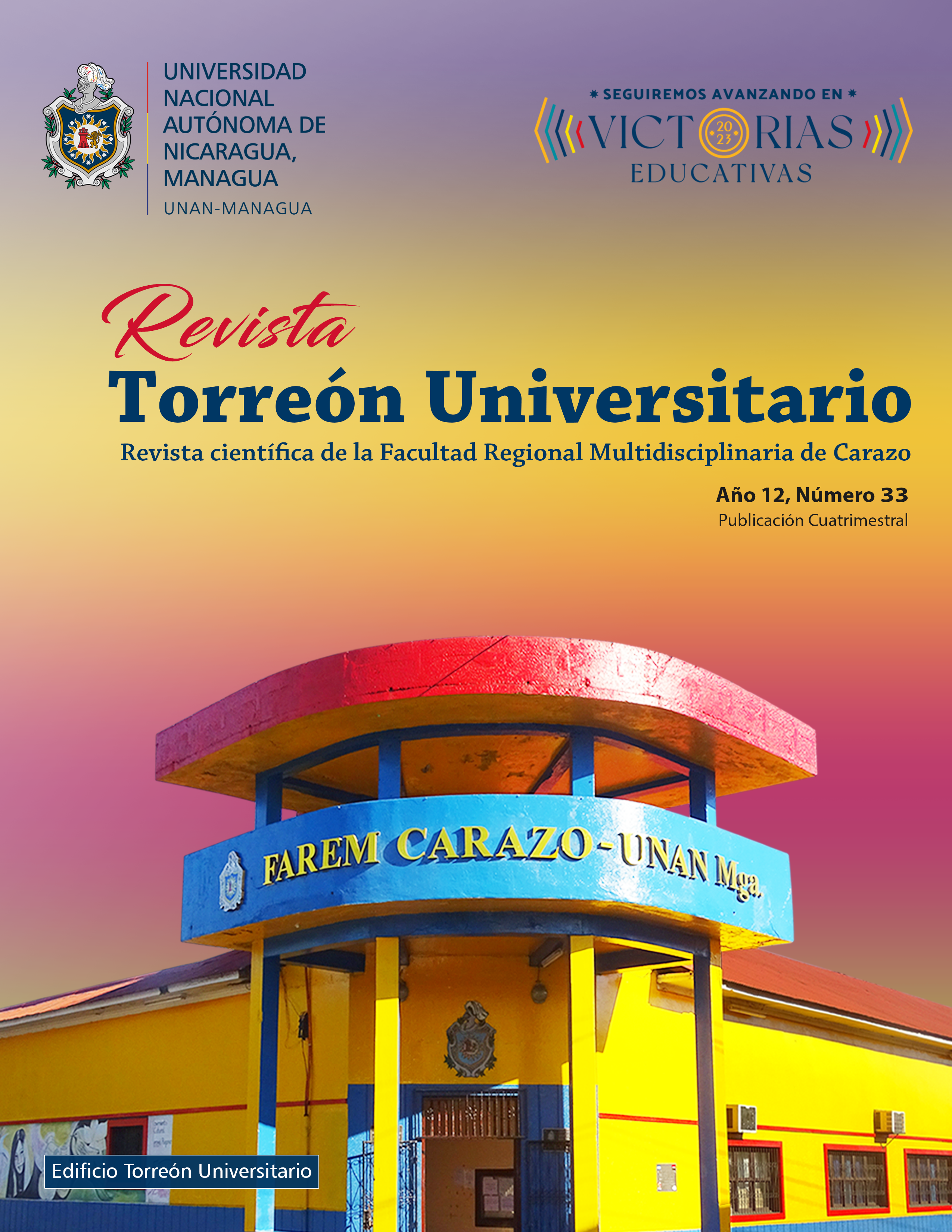Characterization of the visual deterioration and refractive state of the administrative workers of the UNAN-Managua in the year 2020
DOI:
https://doi.org/10.5377/rtu.v12i33.15894Keywords:
Refractive errors, visual impairment, visual acuityAbstract
The purpose of this research was to characterize the visual impairment and refractive status of the administrative workers of the UNAN - Managua in the year 2020. The study is descriptive, correlational; according to the time of occurrence of the events and recording of the information, the study is retrospective, due to the period and sequence of the study it is cross-sectional, 220 clinical files of administrative workers from five faculties including the IPS, attended in the UNAN eye care clinic - Managua, descriptive. Among the main results, 48.12% of the population presented some degree of visual acuity deterioration, where Hyperopia with 29% and Hypermetropic Astigmatism with 25%, are the most prevalent refractive errors. While the refractive error with the lowest prevalence was Myopia with 10%, while the associated refractive condition with the highest prevalence was Presbyopia with 71%. Farsightedness, Hypermetropic Astigmatism and Presbyopia, lead to a significant impact on work processes in near vision, by the administrative workers of UNAN - Managua; The diagnosis and adequate treatment of refractive conditions and associated refractive conditions can significantly influence the improvement of the visual function of the study population, work activities and better quality of life.
Downloads
References
Borras, M. R. (1998). Optometría Manual de Procedimientos Clinicos. Cataluya: UPC.
Castiella, J. (1998). La refracción en el niño. Madrid: Mc Graww Hill Interamericana.
Frick et al, K. D. (2015). The global burden of potential productivity loss from uncorrected presbyopia. Ophthalmology., 122(8), 1706 - 10.
García et al, A. J. (2016). Valoración de la agudeza visual. Revista Pediatrica Atención Primaria, pp.267 -274. Obtenido de http://scielo.isciii.es/pdf/pap/v18n71/1139-7632-pap-18-71-00267.pdf
Hashemi et al, H. (2018). Global and regional estimates of prevalence of refractive errors: Sistematic Review an meta -analysis. Journal of Current Ophthalmology, pp. 3 -22.
Hashemi et al, H. (2018). Global and regional estimates of prevalence of refractive errors: Systematic Review an meta-analysis. Journal of Current Ophthalmology, pp.3-22.
Hernández, R., & Mendoza, C. P. (2018). Metodología de la Investigación - Las rutas cuantitativa, cualitativa y mixta. En R. Hernández - Sampierí, & C. P. Mendoza Torres, Metodología de la Investigación - Las rutas cuantitativa, cualitativa y mixta (págs. pp. 612- 630). Ciudad de Mexico: Mc Graw Hill.
Lapido et al, S. I. (2012). Alteraciones de el polo posterior en pacientes con miopía degenerativa. Revista cubana de Oftalmología, 288-302.
Leske et al, M. (1991). The Lens Opacities Case-Control Study. Risk factors for cataract. archive Ophthalmol, pp.244-251.
Marcus et al, M. (2011). Myopia as a risk factor for open-angle glaucoma: a systematic review and meta-analysis. Ophthalmology, pp.1989-1994.
Mártinez, J., Robaie, D., & Kiffley, A. (2007). Prevalence of Hyperopia and Associations with Eye Findings in 6- and 12-Year-Olds. American Academy of Ophthalmology, p. 61.
Munch Galindo, L. (1996). Métodos y Técnicas de Investigación (Tercera Reimpresión ed.). Editorial Trillas.
Naidoo et al, K. (2019). Potential lost productivity resulting from the global burden od myopia: sistematic review, meta-analysis, and modeling. Ophthalmology, 126 (3), 338 - 46.
Nickels, S., Pfeiffee, N., & Schuster, A. (2019). Myopia is associated with education: Results from NHANES 1999-2008. PLOS one, p.11.
OMS. (2020). Informe Mundial de la Visión. Oganización Mundial de la Salud(ISBN 978-92-4-000034-6). Recuperado el 19 de julio de 2021, de https://apps.who.int/iris/bitstream/handle/10665/331423/9789240000346-spa.pdf
Piura, L. J. (2006). Metodología de la Investigación Científica: Un Enfoque Integrador. Managua: PAVSA.
Supo, J. (11 de marzo de 2015). Estadístico. Obtenido de https://www.youtube.com/watch?v=0ipkoipLB3M
Zapata, V. (2018). Discapacidad visual y errores refractivos en mayores de 15 años. Ciencia Unisalle, p. 1. Obtenido de Zapata, V. (2018). Discapacidad visual y errores refractivoObtenido de https://ciencia.lasalle.edu.co/optometria/258
Published
How to Cite
Issue
Section
License
Copyright (c) 2023 National Autonomous University of Nicaragua, Managua

This work is licensed under a Creative Commons Attribution-NonCommercial-NoDerivatives 4.0 International License.
Los autores que publican en esta revista están de acuerdo con los siguientes términos.
- El autor o los autores de los artículos, ensayos o investigaciones conceden a la Universidad Nacional Autónoma de Nicaragua, Managua (UNAN-Managua) los derechos de edición (copyright) del trabajo enviado, por consiguiente la Universidad cuenta con el derecho exclusivo para publicar el artículo durante el periodo completo de los derechos de autor.
- Estos derechos de autor/ autores autorizan a la Revista Torreón Universitario y a la Universidad editar y divulgar/publicar el artículo en dicha Revista, incluyendo reproducción impresa y electrónica, el almacenamiento, recuperación y cualquier otro tipo de publicación, y fuentes de información secundaria como servicios de resúmenes y bases de datos, así mismo la facultan a proteger el artículo contra el uso no autorizado para su difusión por medios impresos o electrónicos (PDF, HTML, EPUB, XML u otros).
Licencia para el uso del contenido
La revista hace uso de la Licencia Creative Commons Atribución-NoComercial-SinDerivar 4.0 Internacional.
Bajo esta declaración:

Este revista está sujeta a una licencia de Creative Commons Reconocimiento-NoComercial-SinObraDerivada 4.0 Internacional. Puede ser copiada, distribuida y transmitida públicamente siempre y cuando se cite al autor y la fuente (Revista Torreón Universitario), no debe modificarse ni utilizarse con ningún fin comercial. La licencia completa se puede consultar en http://creativecommons.org/licenses/by-nc-nd/4.0/.

